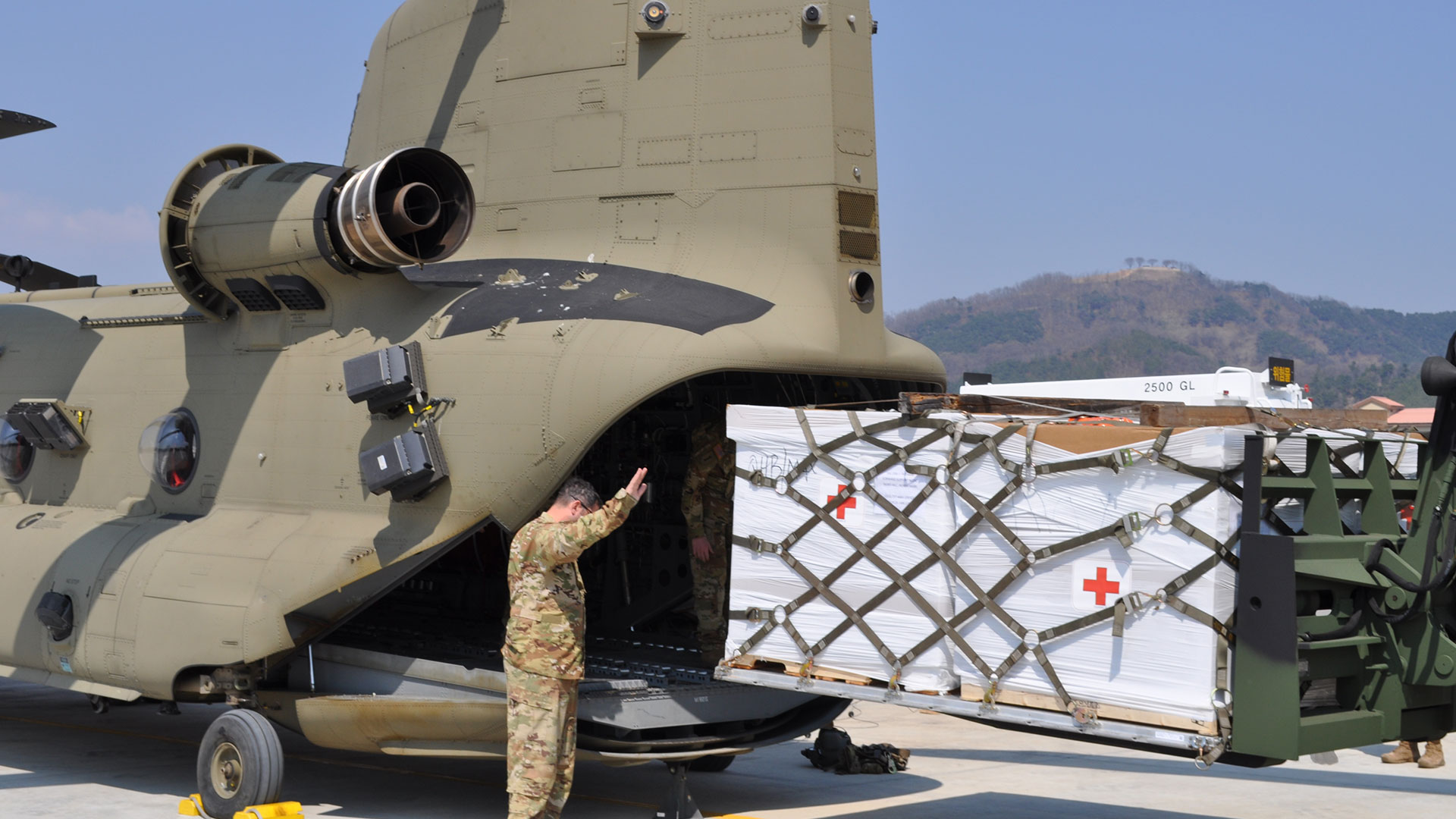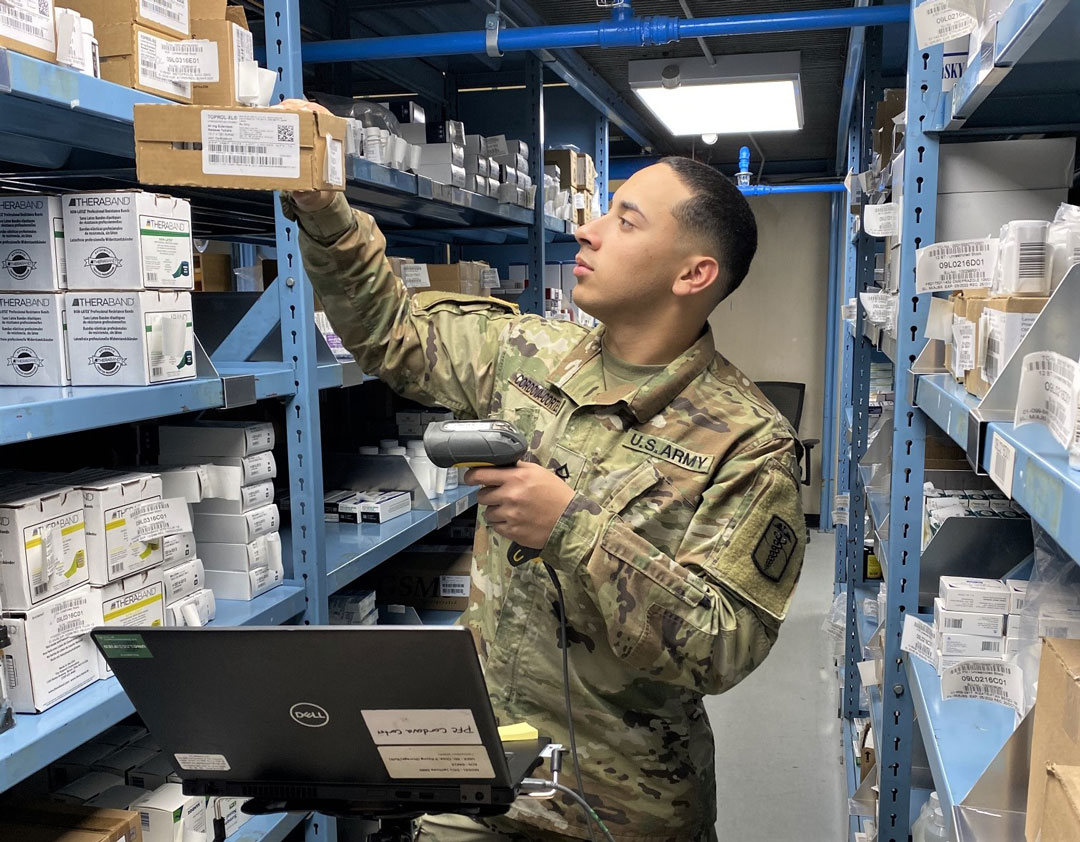
SUPPLY IN THE SKY: Soldiers from the 563rd Medical Logistics Company, then a tenant unit of the U.S. Army Medical Materiel Center-Korea, load Class VIII medical supplies onto a CH-47 helicopter with guidance from the crew chief of the 2nd Combat Aviation Brigade, 2nd Infantry Division on March 24, 2020. (Photo by Shawn Hardiek, Army Medical Logistics Command)
What it takes to sustain operational health care.
by Col. Shane Roach and Lt. Col. Marcus D. Perkins
When Soldiers deploy, they rarely go alone. The U.S. military services not only fight together—Soldiers, Sailors, Airmen, Marines and Guardians—but they also rely on partner nations and allies. To enable this joint warfighting capability, the military uses a joint concept known as the Theater Lead Agent for Medical Materiel (TLAMM). These lead agents exist to plan, prepare and execute medical materiel readiness in any operational tempo.
WHAT IS A TLAMM?
A TLAMM is a unit or organization—in the Army’s case, medical materiel centers—that has been designated by the chairman of the Joint Chiefs of Staff on recommendation from the Defense Logistics Agency (DLA), combatant commanders and branches of service. TLAMMs cover specific theaters and support the medical supply chain needs of joint forces and the U.S. Department of State operating, assigned or attached to a geographic combatant command. Their core functions are to:
- Manage medical materiel storage and distribution.
- Conduct medical maintenance.
- Perform optical fabrication.
- Assemble medical sets and rebuilds.
- Provide customer support and training opportunities for Soldiers in theater.
WORLDWIDE NODES OF SUPPORT
The Army has three designated TLAMMs, including: U.S. Army Medical Materiel Center-Europe (USAMMC-E), U.S. Army Medical Materiel Center-Korea (USAMMC-K) and U.S. Army Medical Materiel Center-South West Asia (USAMMC-SWA).
Located at Kaiserslautern, Germany, USAMMC-E serves as the TLAMM for U.S. European Command (EUCOM) and U.S. Africa Command. USAMMC-E also provides medical materiel support for U.S. Department of State operations in the region. Working in collaboration with the 21st Theater Sustainment Command, USAMMC-E supports more than 1,200 Army, Navy, Air Force and Department of State hospitals, clinics, embassies and field units. USAMMC-E maintains a warehouse inventory of 6,040 different items and a catalog of more than 45,000. In recent years, the center has received annual requests for Class VIII materiel up to $173 million, as well as handling fabrication services for more than 60,000 optical pieces annually and maintenance for over 4,000 medical devices each year.
Situated at Camp Carroll and Camp Humphreys, South Korea, USAMMC-K serves as the TLAMM for U.S. Forces Korea. USAMMC-K, which was designated as a TLAMM in 2009, works closely with its strategic partners to support all U.S. and allied forces on the Korean peninsula. USAMMC-K contributes to Eighth Army medical readiness by managing and fielding countermeasures used in the protection and treatment of Soldiers in the event of a chemical, biological, radiological or nuclear attack. Countermeasures include pretreatment, treatment, antidotes and skin decontamination, as well as potency and dated items used in patient chemical agent medical equipment sets.
Finally, USAMMC-SWA is located at Al Udeid Air Base, Qatar, and serves as the TLAMM for U.S. Army Central Command (CENTCOM). USAMMC-SWA was provisionally activated at the onset of Operation Enduring Freedom in 2002. From 2003 to present, USAMMC-SWA has supported numerous named operations including Enduring Freedom, Inherent Resolve, Freedom’s Sentinel, Resolute Support and Operation New Normal. In 2021, as part of CENTCOM’s base realignment initiative, USAMMC-SWA relocated to Al Udeid. This was a herculean endeavor, conducted during the COVID-19 pandemic, requiring the move of over 1,000 pallets of supplies and equipment in 21 days solely by USAMMC-SWA’s organic personnel, a platoon size element of less than 40 Soldiers. This move, however, presented numerous operational benefits. Al Udeid Air Base provides SWA with direct access to a main aerial port, reducing country customs processing and transportation times to over 140 customers operating in 12 different countries.
USAMMC-E and USAMMC-K are direct reporting units to Army Medical Logistics Command, the Army’s lifecycle management command for medical materiel, while USAMMC-SWA is still a provisional unit under the direction of CENTCOM. Additionally, it is worth noting that there are two TLAMMs operated by the U.S. Air Force. They include the Air Force Medical Readiness Agency in San Antonio, Texas, which serves as the TLAMM for U.S. Northern Command and U.S. Southern Command, and the 18th Medical Group, which is at Kadena Air Base, Japan, and serves as the TLAMM for U.S. Indo-Pacific Command.

HANDLE WITH CARE: Pfc. Raul Cordova performs duties as a storage materiel handler at the U.S. Army Medical Materiel Center-Korea warehouse. His duties include collection of Class VIII medical supplies and preparing them for shipment to customers. (Photo courtesy of Army Medical Logistics Command)
LINKING STRATEGIC AND OPERATIONAL MEDICAL LOGISITICS
U.S. code requires that each service branch provide its own logistics support, but in a joint operations setting where two or more services are operating, a combatant commander may assign duties to one specific branch to serve as the lead agent. In assigning those duties, it establishes a mission known as Single Integrated Medical Logistics Management (SIMLM), which promotes supply chain efficiency and minimizes the medical logistics footprint within theater.
According to Joint Publication 4-02.1: JTTP for Health Service Logistics Support (HSLS) in Joint Operations, “the SIMLM system encompasses the provision of medical supplies, medical equipment maintenance and repair, blood management, and optical fabrication to all joint forces within the theater of operations including, on an emergency basis, [U.S. Navy] ships for common-use items. By exercising directive authority over the HSLS arena for the accomplishment of assigned missions, the Commander of the Combatant Command (CINC) can centralize control, reduce duplication of services and provide the support in a more economical and efficient manner.”
In its simplest form, the SIMLM can be thought of as a board of directors that establishes priorities and streamlines operations, while the TLAMM serves as the “store” of supplies and equipment.
As TLAMMs, USAMMC-E and USAMMC-K have been tasked by their respective combatant commands, EUCOM and U.S. Forces Korea, in accordance with Army Regulation 40-61 on medical logistics policies, to operationalize the SIMLM mission in support of the joint force in their respective theaters of operation. Similarly, CENTCOM has tapped Army Central Command as the SIMLM for its theater campaign plan, using USAMMC-SWA as its TLAMM.

MEDICAL MAINTENANCE IN CHECK: A worker at the U.S. Army Medical Materiel Center-Europe performs maintenance on a medical device. USAMMC-E’s Clinical Engineering Division specializes in the repair, modification and overhaul of medical equipment. (Photo by Ellen Crown, Army Medical Logistics Command)
LESSONS LEARNED FROM COVID-19
As the COVID-19 pandemic ramped up in early 2020, even people unfamiliar with logistics saw how supply chain disruptions can impact access to necessities. For the military, much of the responsibility to ensure a smooth, seamless distribution—and redistribution—of personal protective equipment, medical testing supplies and vaccines fell on the TLAMMs.
What we learned is that when needed, the TLAMMs deliver on the promise to provide life sustaining support and supplies. But like most missions, the TLAMMs didn’t fight the battle alone. Throughout the pandemic, the TLAMMs leveraged strong teamwork to complete the mission. As an example, USAMMC-SWA collaborated closely with USAMMC-E, DLA-Medical, U.S. Transportation Command and other partners to distribute over 80,000 doses of vaccine to 12 different countries with zero loss or spoilage.
The necessity to quickly deliver vaccines from the continental U.S. to theater helped leaders establish new and direct supply routes. Direct shipping via commercial carriers to USAMMC-SWA, as opposed to cross-docking in Europe, drastically reduced shipping times and the risk of temperature changes resulting in spoilage. In that way, the COVID-19 response effort shined a light on the USAMMC-SWA’s potential to speed other medical materiel needs rapidly from the continental United States to theater in the event of an operational surge or additional crisis response.
As distribution of COVID-19 vaccines ramped up globally in early 2021, USAMMC-E was at the tip of the spear supporting troops and beneficiaries throughout Europe, Africa and the Middle East. USAMMC-E teams procured specialized cold-chain shipping containers and oversaw the safe transport of COVID-19 vaccine doses across the complex geographical region. Working closely with DLA, USAMMC-E’s leadership role in the wider distribution operation ensured all three combatant commands it supports received needed doses and maintained readiness in the face of the global pandemic.
DLA oversaw distribution efforts for many medical treatment facilities across Europe, while USAMMC-E handled logistics to ensure doses went out to more difficult to reach locations. In Korea, USAMMC-K worked closely with U.S. Forces Korea leadership to ensure materiel support was in place for all facets of the COVID-19 response effort. The center’s deliberate and proactive approach enabled smooth distribution of the vaccine, along with the redistribution of unused doses to U.S. Northern Command, U.S. Central Command and U.S. European Command, as well as eight medical facilities and one distribution node in Qatar.
And—though not a TLAMM—Army Medical Logistics Command (AMLC) served as a key strategic integrator in the Army’s COVID-19 response worldwide. AMLC worked closely with the Air Force Medical Readiness Agency, as the TLAMM for U.S. Northern Command, to orchestrate Army support for the COVID-19 response in the U.S. The AMLC directed the U.S. Army Medical Materiel Agency (USAMMA) to provide packages of medical equipment and supplies to help stand up two hospitals—one in New York and the other in Seattle. Both packages were delivered to the units within 72 hours of notification of approval. USAMMA also supported the repair, calibration and issue of medical equipment in support of deploying U.S. Army Forces Command hospitals and units.
Additionally, in coordination with the Tank-Automotive and Armaments Command, AMLC supported the materiel management and distribution of COVID-19 test kits across multiple locations both in and out of the continental United States, supporting 33 DHA medical facilities in four areas of operation.

SPECIAL DELIVERY: A Soldier from the 563rd Medical Logistics Company unloads a delivery of medical supplies to support the medical materiel response to COVID-19. (Photo by Sgt. 1st Class Gerald Sim, Army Medical Logistics Command)
READINESS MULTIPLIER
TLAMMs are an essential piece of strategic support in a forward-operating environment. Without the TLAMM, there simply is not enough medical logistics bandwidth within the tactical units at the field level, jeopardizing operational readiness through delays and back orders in medical materiel requirements.
Turnaround time on medical supply orders would significantly increase, with DLA and joint service units left to continue the mission at reduced capability and capacity. And that is if the medical supplies even make it there. TLAMMs are experts at navigating the geopolitical relationships and host nation requirements for certain materiel, including hazardous and controlled substances such as certain medications. Without a TLAMM, units would be left to figure out these processes on their own.
CONCLUSION
Joint forces depend on TLAMMs. Every warfighter depends on TLAMMs. Soldiers go into harm’s way having faith that if they fall sick or become injured, the medical equipment and supplies will be there to save and restore their heath. TLAMMs are keeping that promise to our warfighters by delivering essential medical logistics support to maximize operational readiness.
For more information, go to https://www.amlc.army.mil/.
COL. SHANE ROACH serves as commander of the U.S. Army Medical Materiel Center-Europe. He is a graduate of numerous military schools, including the Command and General Staff College, Joint and NATO planners courses and the Combined Logistics Officer’s advance course. He holds a Master of Education degree in curriculum and instruction from Lewis University and a master’s in strategic studies from the Air Force War College.
COL. MARCUS D. PERKINS serves as commander of the U.S. Army Medical Materiel Center-Korea. He is a graduate of numerous military courses, including the Medical Logistics Management course, Intermediate Level Education at the Command and General Staff College and Lean Six Sigma (Green Belt). Perkins holds a master’s in procurement and acquisition management from Webster University and a B.S. in nuclear technologies from Wayland Baptist University.







